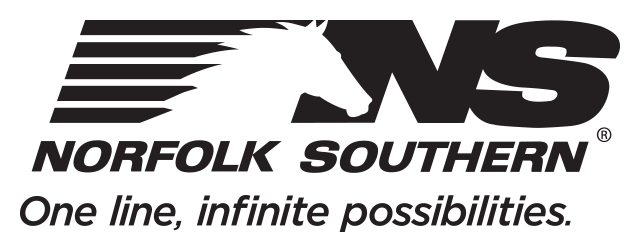Rail’s Environmental Advantage
Sustainable Transportation

Moving freight by rail offers an efficient, cost-effective, and immediate way to reduce U.S. greenhouse gas emissions. If only 10 percent of long-distance freight now moving by truck moved by rail instead, annual U.S. fuel savings would approach nearly 1 billion gallons and greenhouse gas emissions would fall by around 11 million tons, based on a comparative study of the fuel efficiencies of trains vs. trucks.
The independent study, conducted for the Federal Railroad Administration, shows that trains are the most environmentally friendly way to move freight over land. The 2009 study revealed that trains are between 1.9 and 5.5 times more fuel-efficient than trucks – depending on the commodity being transported and length of haul – and generate up to two-thirds fewer greenhouse gas emissions.
Comparing trains and trucks on 23 different routes, the study found that rail fuel efficiency was higher than truck fuel efficiency on every route in terms of ton-miles of freight per gallon. Rail fuel efficiency varied from 156 to 512 ton-miles per gallon, while truck fuel efficiency ranged from 68 to 133 ton-miles per gallon.
The study provided a comparative evaluation of rail and truck fuel efficiency on corridors and for services over which both trains and trucks compete. Competitive moves were defined as those involving the same commodity and having the same or proximate origin and destination points. The study included a mix of short-, medium-, and long-distance movements; a mix of different commodities and different railcar and truck types; and a mix of geographic regions.
In addition, using trains instead of long-haul trucks helps reduce congestion on interstate highways. The Texas Transportation Institute’s 2012 Urban Mobility Report found that highway congestion annually wasted 2.9 billion gallons of fuel, generated 56 billion pounds of additional CO2, and carried financial costs of $121 billion. About $27 billion of that cost was attributed to wasted time and diesel fuel from trucks moving freight on the highway system.
Shippers Recognize Rail’s Eco-Friendly Benefits
More companies are strategically shifting their mode of product transportation to rail to reduce their supply-chain carbon footprint and achieve business sustainability goals.
In their corporate sustainability reports, some of Norfolk Southern’s largest customers are making note of the move from trucks to rail and intermodal transport. Intermodal land transport typically involves rail for the primary move, with trucks providing short-haul moves for door-to-door customer pickup and delivery. Examples of our customers’ shift to rail transport include:
- BMW in its 2013 Sustainable Value Report said that the company is shifting to “low-carbon modes” of transportation where possible, reporting that the share of vehicles shipped by rail from BMW Group facilities increased to 60.7 percent in 2013, up from 56.9 percent the previous year.
- J.B. Hunt stated in its Sustainable Innovations report that converting over-the-road shipments to intermodal is part of its approach to sustainability. The trucking company estimated that converting to intermodal saves on average more than 200 gallons of fuel and 2 tons of carbon gas emissions per shipment.
- Kimberly-Clark stated in its 2012 Sustainability Report that maximizing use of intermodal to transport its consumer products has reduced diesel fuel use by more than 100 gallons per shipment and carbon dioxide emissions by 2,600 pounds per shipment. The company said it has increased use of intermodal by 86 percent since 2006, reducing diesel fuel consumption by 66 million gallons and saving more than 700,000 tons of carbon dioxide equivalents.
- Procter & Gamble in its 2013 sustainability report said the company has a 2020 goal to reduce truck transportation kilometers by 20 percent per unit of production versus its 2010 baseline. The company said it had reduced truck transportation kilometers by approximately 12 percent since 2010, in part by converting loads to intermodal – taking kilometers off the road to reduce pollution.
- TJX Companies in its 2013 corporate responsibility report said it is reducing fuel costs and carbon footprint through expanded use of rail intermodal for shipping merchandise. The value retailer said that in the U.S., the company had increased the use of inbound intermodal to distribution centers from 30 percent of miles traveled in fiscal year 2008 to 69 percent of miles traveled in fiscal 2013. The company said it intends “to continue using this greener transportation alternative to reduce both our costs and logistics-related emissions” as U.S. rail service continues to improve.
- Unilever in its 2013 Sustainable Living plan discussed using rail to help meet a 2020 CO2emissions-reduction goal. “Transporting our goods to markets by rail is an effective way for us to grow our business sustainably,” Unilever noted.
- UPS in its 2012 sustainability report noted that trains provide a low-carbon transportation alternative to road and air transport, and said the company avoided 0.9 million metric tons of carbon emissions for the year by shifting delivery volume from ground to rail.

